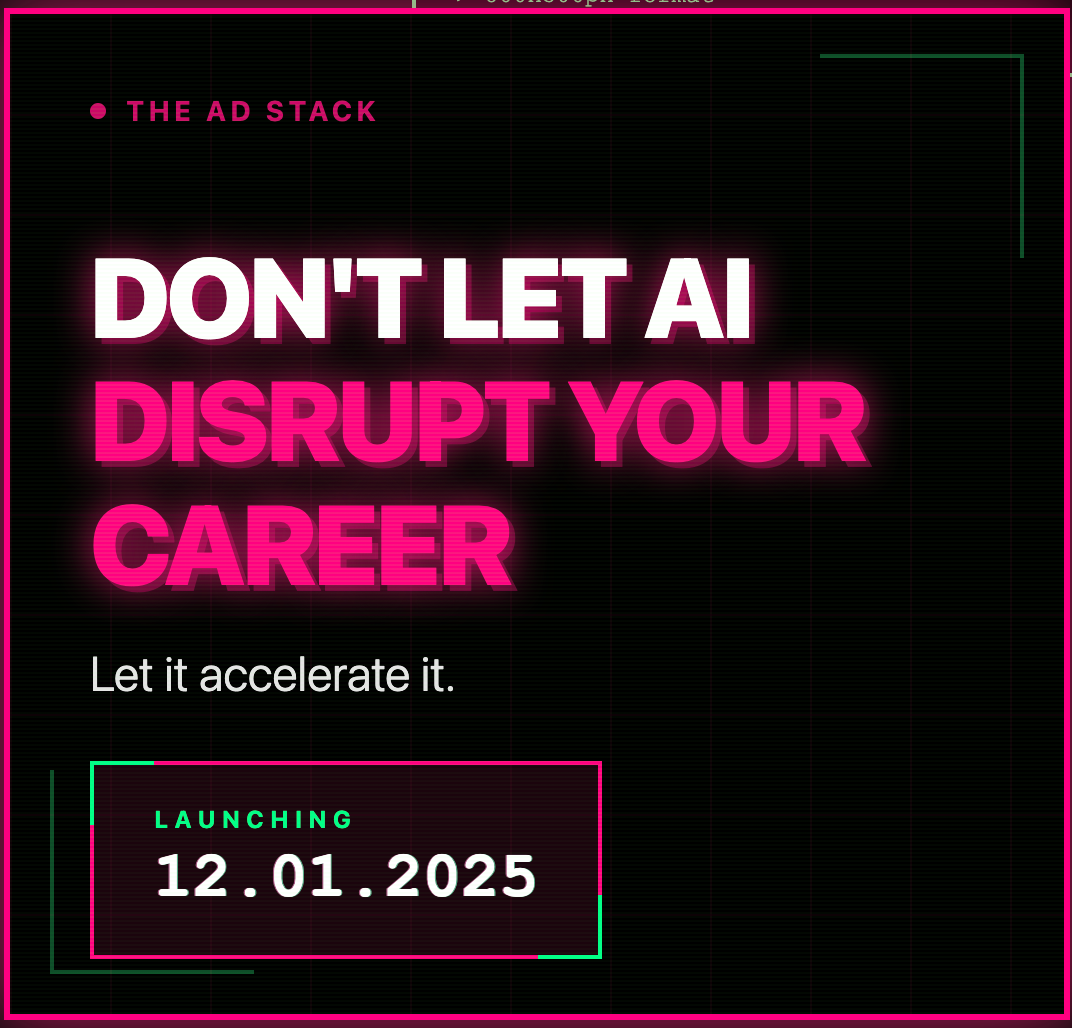86. AI warning label: "AI Amplifies Your Sh*t Strategy"
Also "The Great Emotional Bake-off!"
Hello.
The big picture: Today’s my birthday. Another circle around the sun completed.
If you would do me the favor of sharing this newsletter with 10 people (or one) I would greatly appreciate it.
We’re at 815 as I’ve been “pruning” less active accounts. If we can get subscribers to 1,000 I’m thinking a pizza party may be in our future. CTA-press the button at least three time!
Finally, The Ad Stack publishes on the web one day prior to the newsletter. I like to have a final look at everything. So if you can’t wait, hit up theadstacker.com
Here we go …
From the editor: AI is shifting from experimental to essential in advertising.
Only about 30% of brands, agencies, and publishers have fully integrated AI.
AI is shifting from experimental to essential in advertising. According to the Interactive Advertising Bureau’s State of Data 2025 report, only about 30% of brands, agencies, and publishers have fully integrated AI across their media campaigns. Still, half of those who haven’t expect to get there by 2026.
It’s no longer just about using AI for bid optimization or targeting. Generative and agent-based tools are starting to influence creative work, media planning, and even media buying.
That said, it’s still early days, and progress isn’t smooth. The biggest challenges are fragmented data, waaaaaay too many f*cking tools are introduced each week, and no clear strategy. Many organizations say their data is messy, scattered across systems, or that they’re still figuring out where AI fits into their workflow.
From your point-of-view in creative production and ad operations, the upside is big: scalable personalization, faster content generation, and tighter feedback loops. But the risks are just as real. Weak data leads to weak results. And without human oversight, AI alone can churn out bland or off-brand work.
So score one for the humans.
Let’s dig in, shall we?
1. AI amplifies your sh*t strategy.
AI doesn’t save you. It accelerates your crash.
You’ve been sold the dream: plug in AI, dump money into PPC, and watch the conversions roll in. Adorable. Here’s what actually happens: if your strategy is garbage, AI doesn’t fix it. It just helps you faceplant at hyperspeed.
AI doesn’t cure incompetence. It turbocharges it.
Hand a Ferrari to someone who can’t drive and they don’t magically become Mario Andretti. They hit the wall faster and with more expensive damage. Digital advertising works the same way. If your targeting is sloppy, your value prop reads like corporate Mad Libs, your funnel is held together with wishful thinking, or your data looks like it was collected by a drunk intern (or CEO), AI won’t save you. It’ll just document your failure in real-time across multiple channels simultaneously.
AI is a megaphone for your mediocrity.
One analysis nailed it: “If your marketing plan is weak, AI won’t save you. It’ll help you fail faster and louder.” Translation: AI is a megaphone for your mediocrity.
Think about it.
When you optimize for the wrong metrics, feed your system data that belongs in a landfill, ignore basic segmentation, and let your creative turn into beige wallpaper, AI doesn’t course-correct. It scales all that dysfunction across every touchpoint you’ve got. Congratulations! You’re not scaling success. You’re weaponizing incompetence.
A PPC Automation blog (evidently this sort of thing is a thing) put it perfectly: Automation only works when your strategy does. Otherwise, it’ll crater your ROAS faster than you can say “quarterly review.” At least when humans screw up, they do it slowly. Hand-crafted almost.
So what does strategic malpractice look like?
Undefined goals
You’re chasing clicks when you need qualified leads. AI can’t read your mind. Well not yet.
Weak messaging
Your creative is so bland it could be an ad for anything. AI will happily scale that nothingness. It can A/B test your way to slightly better mediocrity, but it can’t manufacture a soul.
Garbage data
Fake leads, bot clicks, phantom conversions. Feed your system junk and watch it optimize toward more junk. One study found invalid clicks convert at half the rate of real ones. Surprise: bad inputs create bad outputs. Who could’ve seen that coming?
Disconnected strategy
Your funnel is theoretical, your segments are astrological, and your customer journey is unmapped territory. AI will test variations, sure. But it has no idea why any of them matter. Neither do you, apparently.
Dump AI into that mess and you get fine-tuned, and faster chaos.
And it’s already playing out in real-time. Brands are chasing “AI-powered growth” like it’s a participation trophy while their budgets evaporate and their reputations circle the drain.
Want to make it worse? The landscape is tightening. Margins are razor-thin, competition is brutal, and visibility is disappearing. With AI-generated answers eating search results, organic clicks are becoming an endangered species.
Strategy is no longer optional. It’s the only thing left that matters.
This isn’t just about performance.
It’s about your brand. When AI amplifies lazy messaging or half-baked planning at scale, your audience notices. And when you scale mistakes, the damage compounds. It doesn’t stay small and contained. It metastasizes.
The fix?
Start with the unglamorous basics.
Map your actual funnel.
Define your actual audience.
Clean your actual data.
Write messaging that doesn’t sound like it came from a random corporate buzzword bullshittery.
Test manually.
Build something that works first. Then (and only then) fire up the AI. Let it amplify success, not broadcast failure.
Regarding your broken strategy …
If you’re banking on AI to rescue a broken strategy, here’s a thought: perhaps the problem isn’t the technology. Maybe it’s you. AI won’t steer the car. It just mashes down on the accelerator while you aim at the wall.
2. The Irony Award
The Authenticity Paradox
Welcome to the great emotional bake-off of our time, where AI brands and legacy companies alike are flinging feelings like (ahem) monkey poo at a zoo, hoping something sticks. In one corner, we’ve got the silicon-souled startups spending VC cash trying to look like they understand you. In the other, legacy brands hawking nostalgia like snake oil Trump bitcoin, waving pitchforks at the robot uprising while they quietly automate their supply chains. Everyone’s selling a vibe, and the vibe is fear.
First up: AI companies.
These are the same folks whose core mission is to replace your job with a JavaScript script, and yet they desperately want you to feel seen. Their marketing? A fever dream of TED Talk optimism and font-heavy slide decks. They’ve got empathy maps. They’ve got emotional arcs. They’ve got focus groups full of actors pretending to believe a chatbot is their best friend. It’s like trying to teach a toaster to love you. But sure, let’s pretend your algorithmic babysitter “cares” about your skincare routine.
Their big pitch? That tech can feel things. That predictive analytics equals intuition. That your fridge isn’t just connected, it’s emotionally available. It’s intimate performance art, brought to you by natural language processing. Just don’t ask the AI how it feels about layoffs, unions, or art, unless you’re ready for a PowerPoint on quarterly margins.
Legacy brands smell the panic.
Meanwhile, legacy brands have smelled the panic in the air and are bottling it. “Handmade!” they cry. “Artisanal!” they yell. “100% Non-Synthetic Sincerity!” It’s capitalism in a straw hat, pretending it never heard of Excel macros. Every jar of jam is a manifesto. Every T-shirt is a protest against the Singularity. Buy this soap and you too can join the resistance, presumably with better skin.
And it’s working because nothing sells like moral superiority. Every “crafted with care” tagline is just a slightly more polite way of saying, “We still employ actual people (for now).” It’s marketing as elegy, a swan song for the quaint notion that humans are still in the loop.
Here’s the punchline.
AI brands aren’t here to love you. They’re here to optimize you. And legacy brands? They’ll ditch the human touch the second AI makes it cheaper, faster, and capable of writing copy that doesn’t smell like an Etsy ad.
The real joke? We’re trapped in this tug-of-war between a robotic future no one asked for and a curated past no one can afford. Authenticity has become just another aesthetic, another filter to swipe through. The products may vary, but the pitch is always the same: “Trust us. We’re the real ones.” Until, of course, the cost of “real” gets too high.
Congratulations.
You’ve made it to the authenticity paradox, where sincerity is strategic, emotional connection is a UX feature, and the only thing more artificial than intelligence is the marketing that surrounds it.
Feel free to leave comments and feedback.
Before you go ...
Please forward this to three randos, dorks, colleagues, or someone you met today.
Like and Re-stack it below so others can find it!
Drop a comment below. If you’re into it, if it sucks … perhaps drop a Haiku about programmatic AI. Your call.
Thanks for the read!










